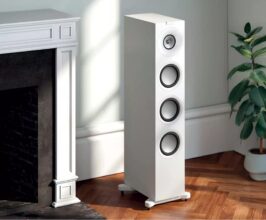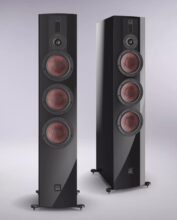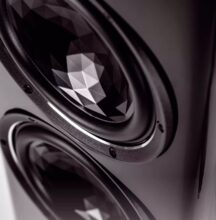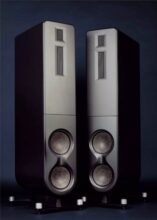Vivid Kaya 45 Review
Vivid Kaya 45 floorstanding loudspeaker
by Jason Kennedy
While some markets like shiny white or yellow loudspeakers, the majority of the hi-fi market appears to prefer rectilinear boxes with a wood veneer.
It has ever been thus and only slowly will it change, but we are finally seeing greater acceptance of paint finishes, especially the less challenging (although determinedly 1980s) gloss black. And I for one could happily make space for white curvy speakers such as those in Vivid Audio’s Giya range.
But I am in a minority on the taste front chez Kennedy and neither can I afford them, so it’s rather academic. But Vivid’s distributor has been dropping hints for a while that a less aesthetically dramatic product might be welcome in the market. So, a few years back when the company’s engineering wizard Laurence ‘Dic’ Dickie met industrial designers Matt Longbottom and Christoph Hermann, he came up with a plan to bring in their talents for what would be the Kaya range.
Up until now, the appearance of Vivid loudspeakers has been essentially a case of form following function that Dic developed alongside the acoustic aspect of the products. This is fundamentally dictated by the tapered absorber tube he developed for the B&W Nautilus when he worked for that company in the 1980s and 1990s (he also came up with Matrix bracing), although for Giya he added an all-important reflex port to the arrangement. That is what the ring in the top of a Giya speaker is, the end of a tapered tube coming off the back of the bass system. The idea with this inverted horn is that when stuffed with appropriate damping material they absorb rather than reflect the energy coming off the back of the driver. There is as much sound produced by the ►

It’s a very attractive and easy to live with shape that from the front is essentially rectangular; it’s only the side view that reveals any curves.
► back of a cone or dome as there is by the front and somehow this has to be diffused or absorbed if it isn’t to bounce back at the cone and distort its output.
For Kaya, Vivid wanted a more conventional look, so Dic gave Longbottom and Hermann the disposition of the drivers, internal volume and wave guide shape for the tweeter and they went away and came up with the squarer (but hardly conventional) shape you see in these images. In fact, if you look at the Kaya from above it has a triangular section and a spine of sorts down the back. The curves are around the edges and toward the base of the speaker where the bass drivers sit. It’s a very attractive and easy to live with shape that from the front is essentially rectangular; it’s only the side view that reveals any curves.
The Kaya 45 (the number indicates internal volume) is the middle model of the three in production so far, its rangemates are the Kaya 25 (which is essentially a standmount with built-in stand) and the Kaya 90 (effectively a larger version of the 45 with four bass drivers). A standmount S15 is in the works as is the C25 centre channel. Clearly Vivid has grasped that there is more to the speaker market than two-channels. The cabinets are constructed in the same way as the Giya range using a vacuum-infused sandwich of composite skins, but unlike that range they have a Soric foam between the skins rather than myriad pieces of end grain balsa. Vivid wants Kaya to be more affordable than Giya and this is one of the key ways they have achieved this, the other is less obvious but relates to finishing. By making Kaya as fluid in shape as it is they have reduced the amount of time it takes to produce the high quality finish that Vivid speakers are renowned for.
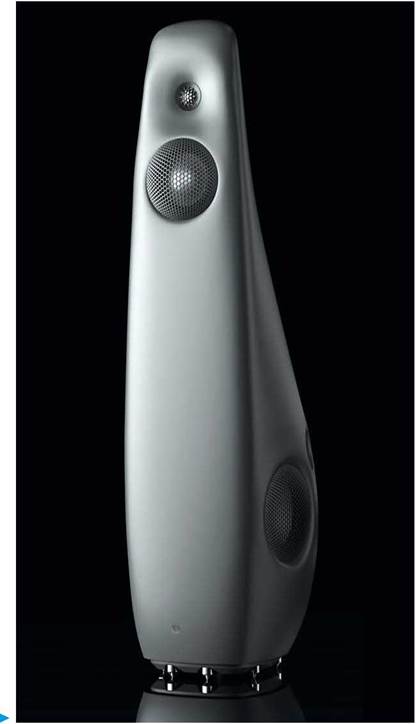
I usually pick just one track as a point of reference, but here I ended up listening to three or four before my reverie was broken by the phone.
This happened with Radiohead’s A Moon Shaped Pool [XL], an album from which I usually pick just one track as a point of reference, but here I ended up listening to three or four before my reverie was broken by the phone. It’s one of those recordings with a lot going on both in terms of different sounds and in the way those sounds are projected into the room; this speaker does both exceptionally well. It’s hyper-revealing of detail but in such a calm, effortless way that you are not so much impressed with the sound as you are absorbed by the musical creativity and the way that the music is being performed. Some parts, like the vocals, are centralised or stay within the space between the speakers while others are thrown out to the sides of the room. The transparent nature of the mids and highs means that the presentation is fluid, musical, and coherent.
It makes other speakers sound like they are producing sonic outlines, whereas this is an oil painting and not a line drawing.
Tone and timbre are also extremely well rendered, which is a factor of the detail definition, of course. I reviewed an album called Ancient Lights by Uniting of Opposites [Tru-Thoughts] on them. This has clarinet, double bass, and sitar among a range of acoustic instruments and sounded particularly lush on the Vivids – the clarinet’s lovely woody richness contrasting with the zing of the sitar and the thunk of double bass. The speaker adds not a hint of grain or edginess to the sound so you can play it as loud as you want for as long as you like (neighbours and partners allowing). I also played a bit of Alison Krauss + Union Station Live [Rounder] and got a hologram of the venue when the crowd’s applause comes in, and then the recording homes in on voice and instruments projecting them with ►
► All the drive units on Vivid loudspeakers are made in house, a very unusual state of affairs for a relatively small company. They were designed by Dickie for the very first models and have evolved since that time using catenary rather than hemispherical domes for the midrange and tweeter and dust cap free cones for bass drivers, all in aluminium. The most recent upgrade is to the magnet systems on the bass drivers in the Giya range; this consists of a rearrangement of the steel whereby the magnet sits right next to the voice coil in order to reduce non-linearities in the behaviour of the magnetic field.
This design of magnet was used first in the bass drivers of the Giya G1 but was later applied to the low mid in the G1 Spirit range topper, so the fact that the same combination is also used in a Kaya 45 makes it something of a bargain. Unlike the four-way Giya this range consists of two- and three-way designs, the Kaya 45 is of the latter persuasion with a 100mm midrange driver having to reach up to the 3kHz crossover point with the tweeter. By 3kHz the midrange driver’s output is beginning to beam or narrrow in dispersion, so the dimple or waveguide for the tweeter is designed to match the dispersion of the two drives by approximating the shape of the mid-cone.
As with all Vivid floorstanders the bass cones are arranged in a reaction cancelling arrangement by virtue of a brace between the motor systems of the two 125mm bass drivers. The tapered tube absorber on the bass system is achieved with a baffle placed within the cabinet that is invisible from the outside. What you can see is a pair of reflex ports one either side and a pair of terminals at the bottom; on our early sample these, connections were right underneath the speaker in typical Vivid style which, while it looks good, makes setting them up a bit of a malarkey, so the move to accessible terminals is a bonus. To minimise the likelihood of tipping, the Kaya 45 has no fewer than six feet and is supplied with high quality spikes and flat feet for more sensitive floors, although getting so many feet evenly weighted might be tricky without spikes.
I have reviewed a good few Vivid designs over the last ten or 15 years and feel like I have got used to their unusually relaxed character, yet as there is at least a year and quite a few other speakers between my Vivid experiences it always takes a little while to come to terms with just how effortless they are. The balance could be described as smooth but that’s because these speakers don’t exhibit the sort of colourations or distortions that you encounter in so many other speakers. The cabinets are both low in weight and highly resistant to vibration so they don’t add their own characteristics to the overall sound, the result is music that escapes the ‘boxes’ with so much ease that you merely have to close your eyes and they disappear. With a good recording it’s nearly impossible to point to each one with any degree of accuracy. I find that if my eyes close when listening it’s a very good sign; it means I’m relaxed and able to focus on the music and that’s something the Kaya 45 does extremely well: so well in fact that you can easily be absorbed in an album for far longer than expected.
Kaya means ‘home’ in Zulu, the language of the people who build Vivid loudspeakers. I would happily give it some space in mine.
extraordinary presence into the room; when that sort of ‘air’ is on the record you will easily hear it with this speaker. That much was apparent with Amandine Beyer’s solo violin [JS Bach Sonatas & Partitas BWV 1001 – 1006, Zig-Zag Territoires]; this usually sounds open and airy but often has an etched quality that fails to expose the full breadth of timbral subtlety that the instrument is capable of. The Kaya 45 allowed the instrument and the large space it was recorded in to be rendered in a more complete fashion than usual, the decay of the space being beautifully preserved around a highly lyrical performance from the violinist.
Bert Jansch’s picking and singing on Jack Orion [Transatlantic] is also surprisingly ‘out of the box’ for its sixties origins. With guitar and voice in one channel and a second guitar in the other it can be very warts and all, with a deeply etched gritty sound but here the attack is played down in favour of the tone and scale of the performance. The elements on this track are often stuck in the speakers, but here they escape into the room and take on an ease and presence that is bewitching. The bass is also particularly well extended and controlled when you have a grippy amplifier like the ATC P2 in command. I was genuinely surprised at how muscular synth and double bass could be; the bass drivers may not be big but two of them arranged this artfully are very compelling. The Kaya 45 does need a bit of power; when I tried the PMC Cor integrated it proved necessary to reduce the bass output on the amp to stop that end of the spectrum from getting overblown. You could do the same thing by bringing the speaker further into the room of course but I’d recommend a fairly stiff amp for best results.
This speaker is for those looking for the finer elements in the music, for the escape that full immersion listening can bring and the beauty of music it reveals. It makes a lot of loudspeakers sound hard edged and distorted; you just have to put on a lively acoustic recording to realise that the approach chosen here is more transparent than most. I chose the Engegard Quartet’s Haydn ‘String Quartet In D, Op. 76, No. 5 – Finale’ (one of the fabulous free downloads from Norwegian label 2L) and got imaging that was to die for and speed that totally nailed the vitality of a live event. It’s as if the players were standing there in the room–an experience that inspired me to connect up the Rega RP10 turntable to play some Tom Waits [Swordfishtrombones, Island]. There it was the dynamics of the kick drum on ‘Underground’ that caught my ear, that and the stunning guitar playing on ‘Shore Leave’ (by Fred Tackett), the speaker bringing out qualities in both that are usually hidden.
The Kaya 45 is not quite in Giya league but it gets close enough in transparency terms and possibly closer in musical ones. But that’s not the point; it costs a lot less and it looks a whole lot less wild while at the same time,
raising the bar rather higher for loudspeakers at this price point in the process. With Kaya, Vivid have made a speaker that gets you very close to the music in a cabinet that while hardly a veneered box is rather more discreet than their usual fare. Kaya means ‘home’ in Zulu, the language of the people who build Vivid loudspeakers, I would happily give it some space in mine.
TECHNICAL SPECIFICATIONS
Type: 3-way, four-driver, floorstanding speaker with glass reinforced sandwich composite cabinet Driver complement: One 26mm
catenary dome aluminium tweeter; one 100mm catenary dome midrange driver; two 125mm aluminium bass drivers Crossover frequencies: 300Hz, 3kHz Frequency response: 37Hz-25kHz (-6dB) Impedance: 6 Ohm (2.8 Ohm min.) Sensitivity: 87dB/W/m Dimensions (HxWxD):
1153 x 298 x 385mm Weight: 25kg/each Finishes: Finishes: Matte Oyster,
Pearl White, Piano Black



